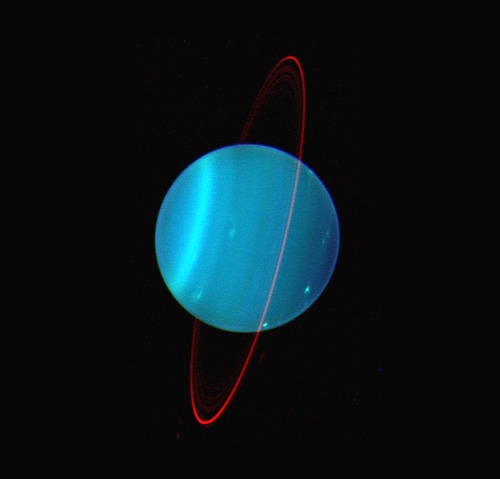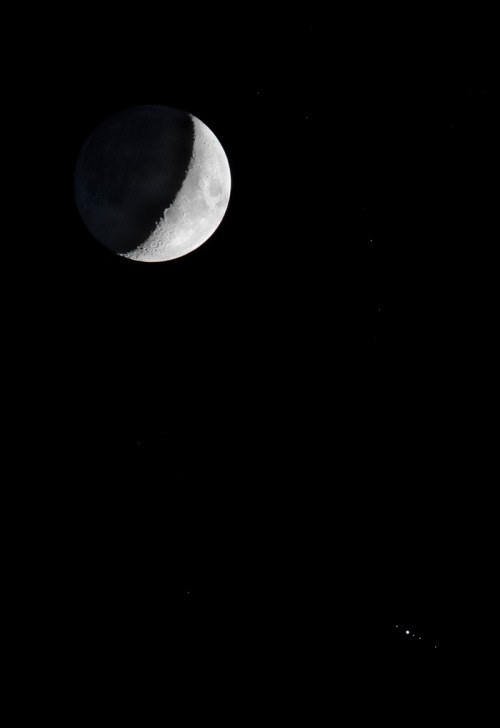The Image Shows An Intensely Bright “ring Of Fire”, As Prof Falcke Describes It, Surrounding A Perfectly

The image shows an intensely bright “ring of fire”, as Prof Falcke describes it, surrounding a perfectly circular dark hole. The bright halo is caused by superheated gas falling into the hole. The light is brighter than all the billions of other stars in the galaxy combined - which is why it can be seen at such distance from Earth.
this is one of those things that hurts my brain to even attempt to wrap my head around
“What we see is larger than the size of our entire Solar System,"
How do you even mentally process that kind of scope? it’s ridiculously and awesome
More Posts from Monecky and Others










Ten interesting facts about Uranus
Like the classical planets, Uranus is visible to the naked eye, but it was never recognised as a planet by ancient observers because of its dimness and slow orbit. Sir William Herschel announced its discovery on 13 March 1781, expanding the known boundaries of the Solar System for the first time in history and making Uranus the first planet discovered with a telescope.

Uranus is the seventh planet from the Sun. It has the third-largest planetary radius and fourth-largest planetary mass in the Solar System. Uranus is similar in composition to Neptune, and both have different bulk chemical composition from that of the larger gas giants Jupiter and Saturn.

(The five largest moons of Uranus) Like all of the giant planets, Uranus has its share of moons. At present, astronomers have confirmed the existence of 27 natural satellites. But for the most part, these moons are small and irregular.

Uranus’ moons are named after characters created by William Shakespeare and Alexander Pope. These include Oberon, Titania and Miranda. All are frozen worlds with dark surfaces. Some are ice and rock mixtures. The most interesting Uranian moon is Miranda; it has ice canyons, terraces, and other strange-looking surface areas.

Only one spacecraft in the history of spaceflight has ever made a close approach to Uranus. NASA’s Voyager 2 conducted its closest approach to Uranus on January 24th, 1986, passing within 81,000 km of the cloud tops of Uranus. It took thousands of photographs of the gas/ice giant and its moons before speeding off towards its next target: Neptune.

Uranus has rings: All the gas and ice giants have their own ring systems, and Uranus’ is the second most dramatic set of rings in the Solar System.

Uranus makes one trip around the Sun every 84 Earth years. During some parts of its orbit one or the other of its poles point directly at the Sun and get about 42 years of direct sunlight. The rest of the time they are in darkness.

All of the planets in the Solar System rotate on their axis, with a tilt that’s similar to the Sun. In many cases, planet’s have an axial tilt, where one of their poles will be inclined slightly towards the Sun. But the axial tilt of Uranus is a staggering 98 degrees! In other words, the planet is rotating on its side.

Uranus is approximately 4 times the sizes of Earth and 63 times its volume.

Uranus is blue-green in color, the result of methane in its mostly hydrogen-helium atmosphere. The planet is often dubbed an ice giant, since 80 percent or more of its mass is made up of a fluid mix of water, methane, and ammonia ices.

Uranus hits the coldest temperatures of any planet. With minimum atmospheric temperature of -224°C Uranus is nearly coldest planet in the solar system. While Neptune doesn’t get as cold as Uranus it is on average colder. The upper atmosphere of Uranus is covered by a methane haze which hides the storms that take place in the cloud decks.
source
source
source
Images credit: NASA/ wikipedia

Lunar Eclipse 2019
Image Credit: Zachary Wells











What do planets look like in the daylight?
via reddit

That view though. Oval storms dot the cloudscape in this enhanced color JunoCam image of Jupiter’s south pole.
This citizen scientist-processed image was taken on Dec. 11, 2016, from an altitude of about 32,400 miles above the planet’s cloud tops.

Same same but different. See cloud patterns near #Jupiter’s south pole in this series of color-enhanced images captured during my latest flyby of the planet.

Jupiter and the Moons via NASA https://ift.tt/31QTY9y
A Tour of Storms Across the Solar System

Earth is a dynamic and stormy planet with everything from brief, rumbling thunderstorms to enormous, raging hurricanes, which are some of the most powerful and destructive storms on our world. But other planets also have storm clouds, lightning — even rain, of sorts. Let’s take a tour of some of the unusual storms in our solar system and beyond.
Tune in May 22 at 3 p.m. for more solar system forecasting with NASA Chief Scientist Jim Green during the latest installment of NASA Science Live: https://www.nasa.gov/nasasciencelive.

1. At Mercury: A Chance of Morning Micrometeoroid Showers and Magnetic ‘Tornadoes’
Mercury, the planet nearest the Sun, is scorching hot, with daytime temperatures of more than 800 degrees Fahrenheit (about 450 degrees Celsius). It also has weak gravity — only about 38% of Earth’s — making it hard for Mercury to hold on to an atmosphere.
Its barely there atmosphere means Mercury doesn’t have dramatic storms, but it does have a strange “weather” pattern of sorts: it’s blasted with micrometeoroids, or tiny dust particles, usually in the morning. It also has magnetic “tornadoes” — twisted bundles of magnetic fields that connect the planet’s magnetic field to space.

2. At Venus: Earth’s ‘Almost’ Twin is a Hot Mess
Venus is often called Earth’s twin because the two planets are similar in size and structure. But Venus is the hottest planet in our solar system, roasting at more than 800 degrees Fahrenheit (430 degrees Celsius) under a suffocating blanket of sulfuric acid clouds and a crushing atmosphere. Add to that the fact that Venus has lightning, maybe even more than Earth.
In visible light, Venus appears bright yellowish-white because of its clouds. Earlier this year, Japanese researchers found a giant streak-like structure in the clouds based on observations by the Akatsuki spacecraft orbiting Venus.

3. At Earth: Multiple Storm Hazards Likely
Earth has lots of storms, including thunderstorms, blizzards and tornadoes. Tornadoes can pack winds over 300 miles per hour (480 kilometers per hour) and can cause intense localized damage.
But no storms match hurricanes in size and scale of devastation. Hurricanes, also called typhoons or cyclones, can last for days and have strong winds extending outward for 675 miles (1,100 kilometers). They can annihilate coastal areas and cause damage far inland.

4. At Mars: Hazy with a Chance of Dust Storms
Mars is infamous for intense dust storms, including some that grow to encircle the planet. In 2018, a global dust storm blanketed NASA’s record-setting Opportunity rover, ending the mission after 15 years on the surface.
Mars has a thin atmosphere of mostly carbon dioxide. To the human eye, the sky would appear hazy and reddish or butterscotch colored because of all the dust suspended in the air.

5. At Jupiter: A Shrinking Icon
It’s one of the best-known storms in the solar system: Jupiter’s Great Red Spot. It’s raged for at least 300 years and was once big enough to swallow Earth with room to spare. But it’s been shrinking for a century and a half. Nobody knows for sure, but it’s possible the Great Red Spot could eventually disappear.

6. At Saturn: A Storm Chasers Paradise
Saturn has one of the most extraordinary atmospheric features in the solar system: a hexagon-shaped cloud pattern at its north pole. The hexagon is a six-sided jet stream with 200-mile-per-hour winds (about 322 kilometers per hour). Each side is a bit wider than Earth and multiple Earths could fit inside. In the middle of the hexagon is what looks like a cosmic belly button, but it’s actually a huge vortex that looks like a hurricane.
Storm chasers would have a field day on Saturn. Part of the southern hemisphere was dubbed “Storm Alley” by scientists on NASA’s Cassini mission because of the frequent storm activity the spacecraft observed there.

7. At Titan: Methane Rain and Dust Storms
Earth isn’t the only world in our solar system with bodies of liquid on its surface. Saturn’s moon Titan has rivers, lakes and large seas. It’s the only other world with a cycle of liquids like Earth’s water cycle, with rain falling from clouds, flowing across the surface, filling lakes and seas and evaporating back into the sky. But on Titan, the rain, rivers and seas are made of methane instead of water.
Data from the Cassini spacecraft also revealed what appear to be giant dust storms in Titan’s equatorial regions, making Titan the third solar system body, in addition to Earth and Mars, where dust storms have been observed.

8. At Uranus: A Polar Storm
Scientists were trying to solve a puzzle about clouds on the ice giant planet: What were they made of? When Voyager 2 flew by in 1986, it spotted few clouds. (This was due in part to the thick haze that envelops the planet, as well as Voyager’s cameras not being designed to peer through the haze in infrared light.) But in 2018, NASA’s Hubble Space Telescope snapped an image showing a vast, bright, stormy cloud cap across the north pole of Uranus.

9. At Neptune: Methane Clouds
Neptune is our solar system’s windiest world. Winds whip clouds of frozen methane across the ice giant planet at speeds of more than 1,200 miles per hour (2,000 kilometers per hour) — about nine times faster than winds on Earth.
Neptune also has huge storm systems. In 1989, NASA’s Voyager 2 spotted two giant storms on Neptune as the spacecraft zipped by the planet. Scientists named the storms “The Great Dark Spot” and “Dark Spot 2.”

10. It’s Not Just Us: Extreme Weather in Another Solar System
Scientists using NASA’s Hubble Space Telescope made a global map of the glow from a turbulent planet outside our solar system. The observations show the exoplanet, called WASP-43b, is a world of extremes. It has winds that howl at the speed of sound, from a 3,000-degree-Fahrenheit (1,600-degree-Celsius) day side, to a pitch-black night side where temperatures plunge below 1,000 degrees Fahrenheit (500 degrees Celsius).
Discovered in 2011, WASP-43b is located 260 light-years away. The planet is too distant to be photographed, but astronomers detected it by observing dips in the light of its parent star as the planet passes in front of it.
Make sure to follow us on Tumblr for your regular dose of space: http://nasa.tumblr.com.







-
 1ns3rtr34llygoodn4m3 liked this · 5 years ago
1ns3rtr34llygoodn4m3 liked this · 5 years ago -
 oatmeal-fruit liked this · 6 years ago
oatmeal-fruit liked this · 6 years ago -
 bowiecoded liked this · 6 years ago
bowiecoded liked this · 6 years ago -
 m1yum liked this · 6 years ago
m1yum liked this · 6 years ago -
 debonnaires-tardis liked this · 6 years ago
debonnaires-tardis liked this · 6 years ago -
 supermainstream reblogged this · 6 years ago
supermainstream reblogged this · 6 years ago -
 supermainstream liked this · 6 years ago
supermainstream liked this · 6 years ago -
 celenguini reblogged this · 6 years ago
celenguini reblogged this · 6 years ago -
 celenguini liked this · 6 years ago
celenguini liked this · 6 years ago -
 gallifreanpotterhead reblogged this · 6 years ago
gallifreanpotterhead reblogged this · 6 years ago -
 goldstuddedleather liked this · 6 years ago
goldstuddedleather liked this · 6 years ago -
 saltghosts liked this · 6 years ago
saltghosts liked this · 6 years ago -
 tiberiusmulder reblogged this · 6 years ago
tiberiusmulder reblogged this · 6 years ago -
 walkingsaladshooterfromheaven reblogged this · 6 years ago
walkingsaladshooterfromheaven reblogged this · 6 years ago -
 jimkirkachu liked this · 6 years ago
jimkirkachu liked this · 6 years ago -
 nicholasbholmes reblogged this · 6 years ago
nicholasbholmes reblogged this · 6 years ago -
 nicholasbholmes liked this · 6 years ago
nicholasbholmes liked this · 6 years ago -
 thingsilikeorrepost reblogged this · 6 years ago
thingsilikeorrepost reblogged this · 6 years ago -
 thingsilikeorrepost reblogged this · 6 years ago
thingsilikeorrepost reblogged this · 6 years ago -
 thingsilikeorrepost reblogged this · 6 years ago
thingsilikeorrepost reblogged this · 6 years ago -
 thingsilikeorrepost reblogged this · 6 years ago
thingsilikeorrepost reblogged this · 6 years ago -
 extravagantbooklion-blog liked this · 6 years ago
extravagantbooklion-blog liked this · 6 years ago -
 gumi-sapphire-maebara reblogged this · 6 years ago
gumi-sapphire-maebara reblogged this · 6 years ago -
 gumi-sapphire-maebara liked this · 6 years ago
gumi-sapphire-maebara liked this · 6 years ago -
 bendingthewillow reblogged this · 6 years ago
bendingthewillow reblogged this · 6 years ago -
 nazarbeads liked this · 6 years ago
nazarbeads liked this · 6 years ago -
 eclecticmetric liked this · 6 years ago
eclecticmetric liked this · 6 years ago -
 linscoresby liked this · 6 years ago
linscoresby liked this · 6 years ago -
 geejay999 liked this · 6 years ago
geejay999 liked this · 6 years ago -
 lt-trick liked this · 6 years ago
lt-trick liked this · 6 years ago -
 ravens-cove liked this · 6 years ago
ravens-cove liked this · 6 years ago -
 capwho reblogged this · 6 years ago
capwho reblogged this · 6 years ago -
 bendingthewillow liked this · 6 years ago
bendingthewillow liked this · 6 years ago -
 worldinmywindow2 reblogged this · 6 years ago
worldinmywindow2 reblogged this · 6 years ago -
 xerohourcheese liked this · 6 years ago
xerohourcheese liked this · 6 years ago -
 lulkhel liked this · 6 years ago
lulkhel liked this · 6 years ago -
 scarlet-indigo reblogged this · 6 years ago
scarlet-indigo reblogged this · 6 years ago -
 scarlet-indigo liked this · 6 years ago
scarlet-indigo liked this · 6 years ago -
 clockworkalpaca reblogged this · 6 years ago
clockworkalpaca reblogged this · 6 years ago -
 clockworkalpaca liked this · 6 years ago
clockworkalpaca liked this · 6 years ago -
 thetimetostrikeislater reblogged this · 6 years ago
thetimetostrikeislater reblogged this · 6 years ago -
 thetimetostrikeislater liked this · 6 years ago
thetimetostrikeislater liked this · 6 years ago -
 third-law-of-thermodynamics liked this · 6 years ago
third-law-of-thermodynamics liked this · 6 years ago -
 tiberiusmulder liked this · 6 years ago
tiberiusmulder liked this · 6 years ago -
 gaydreadknight reblogged this · 6 years ago
gaydreadknight reblogged this · 6 years ago -
 consentingcrabgrass reblogged this · 6 years ago
consentingcrabgrass reblogged this · 6 years ago -
 bigtuna108 reblogged this · 6 years ago
bigtuna108 reblogged this · 6 years ago -
 heywafflxs liked this · 6 years ago
heywafflxs liked this · 6 years ago -
 kingu-chan liked this · 6 years ago
kingu-chan liked this · 6 years ago